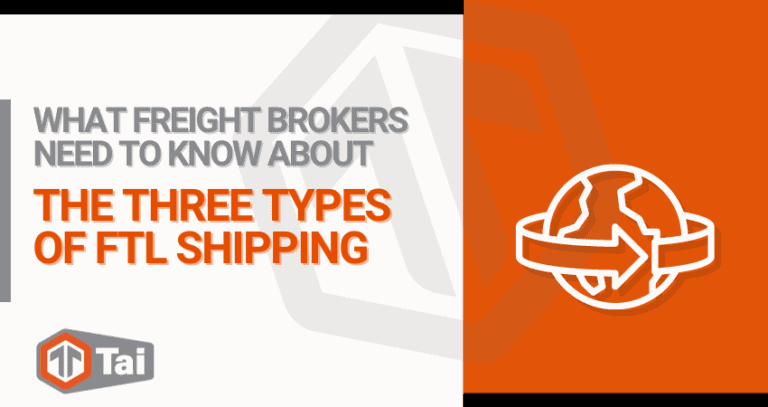Truckload shipping is about the movement of large amounts of cargo, generally enough to fill an entire semi-trailer or intermodal container. Truckload carriers are those that contract an entire trailer-load to a single customer, opposed to a less-than-truckload (LTL) that typically fills the whole truck with multiple shipments from several customers.
One major advantage that Full Truckload (FTL) carriers have over their Less than Truckload and Partial Truckload counterparts is that the freight is never handled while in transit. In contrast, an LTL shipment will be transported via different trailers and temporarily housed in a couple of warehouses before reaching its final destination.
Whenever a large shipment needs to be handled, a 48’ or 53’ capacity trailer will typically not be enough for shipping products. In this case, full truckload shipping is the best option to reduce cost, increase delivery times, and reduce the risk of damage.
There are three main types of truckload shipments that are used in the industry. These include dry vans, flatbeds, and refrigerated freight, which are the most commonly used. Freight brokers will need to know which shipping option is best for each situation when transporting truckload freight. Each of these methods come with their own set of uses, advantages, and disadvantages, which will impact both shippers and carriers involved in hauling freight.
It’s ideal for freight brokers to familiarize themselves with the different freight shipping modes and the requirements that come with each.
What Is Dry Van Shipping?
Dry van shipping is one of the most commonly used and trusted freight transportation methods available for FTL freight shipping. Due to its high availability and benefits of having an enclosed trailer, this method has remained immensely popular when transporting palletized freight.
Dry vans are available in numerous sizes and are made out of different materials. That said, the maximum length allowed for dry vans is 53 feet long. The two most popular types of dry vans are the “general trailers,” which are 53 feet long, and the so-called “pup trailers,” which are between 26 to 29 feet long.
In addition, these dry vans come in several types of materials such as galvanized steel, aluminum, iron, and hardwood.
Here are a few key benefits and drawbacks of dry vans:
Advantages of Dry Van Shipping
- Dry vans are quite versatile. There’s a wide variety of freight that can be transported by using this method. This can include everything from:
- Non-perishable foods and beverages, textiles and clothing, electronics, plastics, and building materials.
- Cars, motorbikes, minibusses, automobiles, along with ship and airplane components.
- Relocating various household goods, furniture, electronics, etc. during the moving process.
- Small machinery and equipment in the construction industry to move raw materials from the warehouse to the construction site, or vice versa.
- These types of trucks are also an excellent option for securing cargo against both bad weather and theft. While some shippers prefer to use load bars with extra bracing, not all dry vans need chains, straps, and other covers.
- The “drop and hook” load mode saves the carrier a lot of time and effort as it takes less time spent manually loading and unloading the cargo.
- Dry vans represent one of the most affordable types of truckload shipments, accommodating both regional and short-haul loads and long-distance transports.
Challenges of Dry Van Shipping
- The hardwood floors used in the majority of dry vans are vulnerable to condensation and moisture. This can lead to extra repairs or replacement costs.
- Similarly, dry vans have no temperature control, insulation, or other climate alterations within the trailers. This means that dry vans are not an option for specific cargo that needs refrigeration.
What Is Refrigerated Shipping?
Also known as reefer shipping, refrigerated freight is a transportation method used for moving temperature-sensitive goods. In reefer shipping, freight is loaded and transported in trailers with built-in refrigeration systems and climate control.
Refrigerated shipping plays a crucial role in the global economy, preventing product deterioration while in transit. Items such as fresh produce, meat, dairy, or pharmaceuticals all rely on refrigerated transportation daily.
Refrigerated trucks are an excellent option for anyone who needs to ship temperature-controlled cargo safely. Similar to dry vans, reefers also have their set of advantages and challenges.
Advantages of Refrigerated Shipping
- One of the key advantages of refrigerated truckload freight is supply and demand. There will always be a demand for fresh products; therefore, the need for refrigerated shipping will always be there to transport these goods. This form of shipping allows carriers to safely and seamlessly transport their goods cross-country.
- Refrigerated trailers are not only limited to transporting refrigerated goods. Dry goods and/or temperature-sensitive freight can also be shipped.
- Refrigerated trucks are also helpful for protecting goods from all sorts of weather conditions, theft, spoilage, and even potential damage.
Challenges of Refrigerated Shipping
- The trailer needs to be cleaned after every load, and controlling the cooling equipment and thermometer are just a few of the extra responsibilities required for the truck driver. They need to set the unit to either a continuous run or a start/stop cycle. Additionally, drivers have to manually defrost the refrigeration unit whenever required. Even to perform basic configurations, drivers need to be familiar with the operations of the refrigeration unit. This poses a challenge for carriers when it comes to driver training, let alone the added risk and costs in the event of a driver mistake.
- The reefer can become quite noisy due to the high-powered motor that is always on.
- Late notifications. Drivers cannot be relied upon to detect a fault if one may occur. They have limited visibility to the unit’s refrigeration controller when on the move.As such, saving a load when something goes wrong will require real-time data and immediate identification and notification, which cannot always be an option.
- Longer wait times are relatively common to experience on shipping docks when it comes to loading and unloading.
- In the event of a breakdown, there may be unavoidable damage done to the cargo.
What Is Flatbed Shipping?
Flatbed shipping is a type of full truckload freight that doesn’t require the enclosure of a dry van. Flatbeds are also used if the cargo cannot be loaded or unloaded from a standard dock or doesn’t fit within the dimensions of typical truck trailers. Cranes and forklifts can load goods from all angles onto a flatbed.
Advantages of Flatbed Shipping
- Flatbed drivers typically earn more per mile than most other trailer types. This, in turn, helps to reduce driver turnover.
- Thanks to the high demand for flatbed shipping within the logistics industry, there are numerous opportunities for pickups and deliveries on a weekly basis.
- Backing into docks to unload freight is not always needed.
- Flatbed trucking services also enable the transportation of less than truckload (LTL) freight that’s very bulky.
Challenges of Flatbed Shipping
- Flatbed trucking requires a high degree of skill on the driver’s part. Most of the loads are typically heavier or can even be classified as oversized.
- Flatbed drivers must also confirm that the freight is adequately secured by using straps or chains. Some loads may also require the use of a tarp. Freight that is poorly secured can be a significant threat on the road.
- Drivers need to check the cargo constantly. Whenever they stop at a restaurant, truck-stop, or rest area, they should examine the straps and chains to make sure that the load hasn’t shifted.
- When weather conditions are unfavorable, transporting oversized loads can become even more complicated and dangerous.
What is Drayage Service?
Finally, any freight broker needs to know about drayage. Simply put, drayage can help fill in the gaps in intermodal shipping by moving large containers for truck, rail, or ship. It’s about moving freight in the form of large containers over short distances. In North America, over 60 million drayage movements happen every year. Drayage companies take containers in and out of harbors, ocean ports, rail terminals, and warehouses and often load them into truck trailers. Drayage is part of a longer logistics process yet amounts to a very short period of the overall shipment travel journey.
Drayage can also mean transporting the cargo to a warehouse, another port, or delivering it to its final destination within a specified radius. Simply put, drayage is an essential step in the supply chain and the only way to move freight from the port or intermodal terminal to the next mode of transport.
Takeaway
Freight brokers will always have to determine the correct freight shipping method for delivering goods to their destination on time, safely, and cost-effectively.
Be it FTL or LTL, dry vans, flatbeds, or reefers; freight brokers need to use the latest digital tools to leverage freight shipping effectively.
Tai Software is a logistics industry solution that addresses every aspect of the shipment life cycle, making it a great TMS software platform for FTL and LTL freight brokers. With a dedicated team of logistics software experts with over 20 years of freight software experience, our team is here to ensure your success. Request a free demo today!










